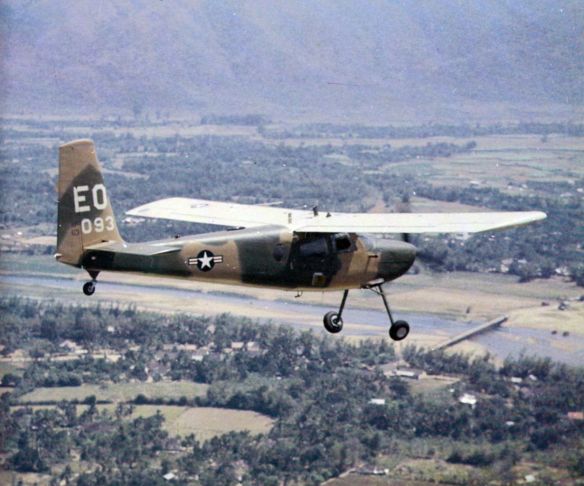A U.S. Air Force Helio U-10B Courier (s/n 63-13093) from the 5th Special Operations Squadron in flight over Vietnam in 1969.
A Farm Gate B-26B over Vietnam.
Air force had continued its special duty flight of transport planes with the Twenty-First Troop Carrier Squadron, during Korean War days familiarly known as the “Kyushu Gypsies.” The unit later moved to Okinawa and, when C-130 aircraft began rolling off the production lines in the late 1950s, some went to the Gypsies. At a stroke this development virtually quadrupled the distance over which clandestine air missions could be carried out. After tours with the CIA and with psychological warfare headquarters in Europe, Heinie Aderholt, perhaps the single most important figure in the evolution of air force unconventional warfare, returned to the Gypsies as a major, leading its special operations detachment. With the air force’s blessings he supported CIA operations in Tibet and Thailand. With the advent of the C-130 the air force had a capability for long-range covert missions.
Short hops into primitive airfields, which would characterize the air effort in Southeast Asia, were a different matter. In the late 1950s the air force introduced its twin-engine C-123 “Provider,” but that went to standard transport squadrons. The army was developing the C-7 as a short-haul light transport. The Provider could carry a bigger load but lacked the short-takeoff-and-landing capacity of its competitor. Conditions in Vietnam and Laos demanded aircraft capable of taking off and landing in these short spaces. In 1962 the air force deployed a Provider version modified for this. Colonel Aderholt took a hand too. During the interval he was assigned to the air branch of CIA paramilitary operations staff, Aderholt had learned of a new single-engine plane that could be ideal. He pressed for adoption of the HelioCourier and succeeded (CIA knew this craft by one name [L-28], the air force by another [U-10]). These three aircraft became mainstays of the air wing within the Studies and Observation Group as well as the CIA proprietary Air America. The war, particularly in Laos, could not have been conducted without them.
Combat capability began with the “Jungle Jim” unit. Partly a result of the air force responding to President Kennedy’s demands, and partly to the service’s dawning awareness that the US military as a whole was reconfiguring itself for counterinsurgency, chief of staff General Curtis E. LeMay moved ahead smartly. Identified with high technology throughout his career, here, in 1960, LeMay approved a unit outfitted with prop-driven T-28 fighter-bombers and B-26 light bombers. This was deliberate. Rapidly transitioning to supersonic aircraft, the air force realized that slow-flying prop planes would have more time to spot targets and strike them. The innocuous 4400th Combat Crew Training Squadron ran its flag up at Auxiliary Field No. 9 of Eglin Air Force Base, Florida, in April 1961. At the time, Hurlbut Field, as it was renamed, consisted of wood-frame single-story barracks, plus sheds left over from World War II. It is today the headquarters of the Air Force Special Operations Command, descendant of the Special Air Warfare Center created there-and rivaling Fort Bragg as an unconventional war mecca-in 1962. Soon enough Jungle Jim left for South Vietnam, where it was given the code name Farm Gate and stationed at Bien Hoa. Officially the aircraft trained crews for the South Vietnamese air force. In actuality they flew strike and bombardment missions, with American pilots accompanied by South Vietnamese observers.
In Laos the strike capability began with Project “Mill Pond,” a CIA operation utilizing B-26 bombers with air force crews seconded to the agency and flying in civilian clothes The ubiquitous Aderholt organized Mill Pond too. And when he returned to the United States, promoted colonel, this officer briefly commanded the First Air Commando Wing, the air force’s initial venture with a full-scale counterinsurgency unit, along the lines of those who’d flown in Burma during World War II. Wing mixed together fighter-bombers, transports, and liaison aircraft, and it became the parent organization for Farm Gate.
A major innovation of air force special warfare during the Vietnam War was the gunship. This was a large aircraft-the C-47 would be the first used, followed by the C-119 and then the C-130-providing a stable platform for side- and/or front-firing heavy weapons and cannon, soon supplemented by electronic systems for targeting. The early C-47 version got the nickname “Puff the Magic Dragon.” When these aircraft entered the force they went to the First Wing. More advanced planes joined the Fourteenth and Twenty-Fourth Wings. All of them were redesignated special operations wings in 1968. The gunships were especially effective in helping to defend outposts or patrols that were under attack, and in armed reconnaissance missions along the Ho Chi Minh Trail. The gunships became established elements of air Special Forces. By 1966 there were six thousand men and 550 aircraft assigned to air special operations.
After Vietnam
Air force special operations, reassigned to the Tactical Air Command, which remained dominated by a mafia of jet fighter pilots who had risen through the Vietnam air campaigns, had held on. It had even developed a new capability-unconventional warriors akin to the army’s old airborne “pathfinders,” airmen who would drop in to a target ahead of mission aircraft and mark it for aircraft landings, the insertion of troops, or be ground observers guiding air strikes. These warriors would not get their name of “Special Tactics Units” until the 1980s-at this time they were known simply as “Brand X”-but they already had the capacity to work alongside Navy and Army Special Forces. With the new units came new terminology, reflecting more closely the multiservice nature of the troops, no longer known simply as Special Forces but as “Special Operations Forces,” the name that is familiar today.
